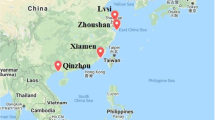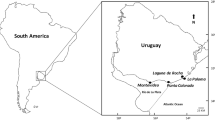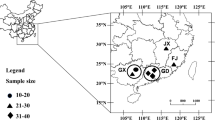Abstract
Regions within the mitochondrial gene encoding for the nicotinamide dehydrogenase subunit 4 (nad4) were characterized to evaluate the extent of genetic variation within and among Xiphinema diversicaudatum and Xiphinema simile populations. Four different sequence variants of nad4 were determined among eight populations of X. diversicaudatum and three variants among three populations of X. simile. Nucleotide variation was detected in 28 of 411 bp (2.43 to 4.87 %) in X. diversicaudatum and in three of 395 bp (0.25 to 0.76 %) in X. simile. This represents the first study based on the characterization of the nad4 gene for the analysis of population genetic of two Xiphinema species.



Similar content being viewed by others
References
Anderson, T. J. C., Blouin, M. S., & Beech, R. N. (1998). Population biology of parasitic nematodes: applications of genetic markers. Advances in Parasitology, 41, 219–283. doi:10.1016/S0065-308X(08)60425-X.
Blouin, M. S. (2002). Molecular prospecting for cryptic species of nematodes: mitochondrial DNA versus internal transcribed spacer. International Journal of Parasitology, 32, 527–531. doi:10.1016/S0020-7519(01)00357-5.
Blouin, M. S., Yowell, C. A., Courtney, C. H., & Dame, J. B. (1998). Substitution bias, rapid saturation, and the use of mtDNA for nematode systematics. Molecular Biology and Evolution, 15, 1719–1727.
Brown, D. J. F., & Boag, B. (1988). An examination of methods used to extract virus-vector nematodes (Nematoda: Longidoridae and Trichodoridae) from soil samples. Nematologia Mediterranea, 16, 93–99.
Gutiérrez-Gutiérrez, C., Castillo, P., Cantalapiedra-Navarrete, C., Landa, B. B., Derycke, S., & Palomares-Rius, J. E. (2011). Genetic structure of Xiphinema pachtaicum and X. index populations based on mitochondrial DNA variation. Phytopathology, 101, 1168–1175. doi:10.1094/PHYTO-07-10-0194.
He, Y., Jones, J., Armstrong, M., Lamberti, F., & Moens, M. (2005). The mitochondrial genome of Xiphinema americanum sensu stricto (Nematoda: Enoplea): Considerable economization in the length and structural features of encoded genes. Journal of Molecular Evolution, 61, 819–833. doi:10.1007/s00239-005-0102-7.
Hu, M., & Gasser, R. B. (2006). Mitochondrial genomes of parasitic nematodes–progress and perspectives. Trends in Parasitology, 22, 78–84. doi:10.1016/j.pt.2005.12.003.
Hugall, A., Moritz, C., Stanton, J., & Wolstenholme, D. R. (1994). Low but strongly structured mitochondrial DNA diversity in root knot nematodes (Meloidogyne). Genetics, 136, 903–912.
Hugall, A., Stanton, J., & Mortiz, C. (1997). Evolution of the AT–rich mitochondrial DNA of the root knot nematode, Meloidogyne hapla. Molecular Biology and Evolution, 14, 40–48.
Hyman, B. C., & Whipple, L. E. (1996). Application of mitochondrial DNA polymorphism to Meloidogyne molecular population biology. Journal of Nematology, 28, 268–276.
Jex, A. R., Littlewood, D. T. J., & Gasser, R. B. (2010). Toward next-generation sequencing of mitochondrial genomes-Focus on parasitic worms of animals and biotechnological implications. Biotechnology Advances, 28, 151–159. doi:10.1016/j.biotechadv.2009.11.002.
Kumari, S., & Subbotin, S. A. (2012). Characterization of Longidorus helveticus (Nematoda: Longidoridae) from the Czech Republic. European Journal of Plant Pathology, 133, 923–933. doi:10.1007/s10658-012-9959-7.
Kumari, S., Decraemer, W., Traversa, D., & Lišková, M. (2009). Molecular and morphological delineation of Longidorus poessneckensis Altherr, 1974 (Nematoda: Dorylaimida). European Journal of Plant Pathology, 123, 125–137. doi:10.1007/s10658-008-9348-4.
Kumari, S., Decraemer, W., De Luca, F., & Tiefenbrunner, W. (2010). Cytochrome c oxidase subunit 1 analysis of Xiphinema diversicaudatum, X. pachtaicum, X. simile and X. vuittenezi (Nematoda, Dorylaimida). European Journal of Plant Pathology, 127, 493–499. doi:10.1007/s10658-010-9614-0.
Lazarova, S. S., Malloch, G., Oliveira, C. M. G., Hübschen, J., & Neilson, R. (2006). Ribosomal and mitochondrial DNA analyses of Xiphinema americanum–group populations. Journal of Nematology, 38, 404–410.
Picard, D., Plantard, O., Scurrah, M., & Mugniery, D. (2004). Inbreeding and population structure of the potato cyst nematode (Globodera pallida) in its native area (Peru). Molecular Ecology, 13, 2899–2908. doi:10.1111/j.1365-294X.2004.02275.x.
Plantard, O., & Porte, C. (2004). Population genetic structure of the sugar beet cyst nematode Heterdoera schachtii: a gonochoristic and amphimictic species with highly inbred but weakly differentiated populations. Molecular Ecology, 13, 33–34. doi:10.1046/j.1365-294X.2003.02023.x.
Sakai, H., Takeda, A., & Mizukubo, T. (2011). First report of Xiphinema brevicolle Lordello et Costa, 1961 (Nematoda, Longidoridae) in Japan. ZooKeys, 135, 21–40. doi:10.3897/zookeys.135.1716.
Sakai, H., Takeda, A., & Mizukubo, T. (2012). Intra-specific variation of Xiphinema brevicolle Lordello et Costa, 1961 (Nematoda: Longidoridae) in Japan. Nematological Research, 42, 1–7.
Stanton, J. M., McNicol, C. D., & Steele, V. (1998). Non–manual lysis of second–stage Meloidogyne juveniles for identification of pure and mixed samples based on the polymerase chain reaction. Australasian Plant Pathology, 27, 112–115. doi:10.1071/AP98014.
Tamura, K., Peterson, D., Peterson, N., Stecher, G., Nei, M., & Kumar, S. (2011). MEGA5: Molecular evolutionary genetics analysis using maximum likelihood, evolutionary distance, and maximum parsimony methods. Molecular Biology and Evolution, 28, 2731–2739. doi:10.1093/molbev/msr121.
Taylor, C. E., & Brown, D. J. F. (1997). Nematode vectors of plant viruses. UK: CABI.
Acknowledgements
The authors are thankful to Drs Lišková and Tiefenbrunner for providing nematodes. The work was supported by the Ministry of Agriculture of the Czech Republic, Project number MZe–0002700604.
Author information
Authors and Affiliations
Corresponding author
Rights and permissions
About this article
Cite this article
Kumari, S., Di Cesare, A. Nicotinamide dehydrogenase subunit 4 analysis of Xiphinema diversicaudatum and Xiphinema simile (Nematoda: Longidoridae). Eur J Plant Pathol 136, 803–810 (2013). https://doi.org/10.1007/s10658-013-0208-5
Accepted:
Published:
Issue Date:
DOI: https://doi.org/10.1007/s10658-013-0208-5




